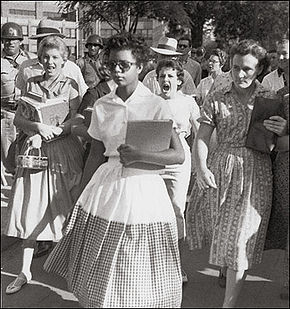
Grace Lorch
Encyclopedia

Civil rights
Civil and political rights are a class of rights that protect individuals' freedom from unwarranted infringement by governments and private organizations, and ensure one's ability to participate in the civil and political life of the state without discrimination or repression.Civil rights include...
activist best known for her work as a white escort for the Little Rock Nine
Little Rock Nine
The Little Rock Nine was a group of African-American students who were enrolled in Little Rock Central High School in 1957. The ensuing Little Rock Crisis, in which the students were initially prevented from entering the racially segregated school by Arkansas Governor Orval Faubus, and then...
.
Lorch was a teacher in Boston and served as President of the Boston Teachers Union and as a member of the Boston Central Labour Council. She was the first teacher to challenge a Boston school regulation that female teachers resign after marriage, although unsuccessfully.
Grace Lonergan married her husband Lee Lorch
Lee Lorch
Lee Lorch is a mathematician and was an early civil rights activist, who is Professor Emeritus of Mathematics at York University in Toronto, Canada.-Background:...
in 1943 as he was about to leave for military service in World War II
World War II
World War II, or the Second World War , was a global conflict lasting from 1939 to 1945, involving most of the world's nations—including all of the great powers—eventually forming two opposing military alliances: the Allies and the Axis...
. Despite having been a teacher for two decades she was dismissed due to an 1880s era rule of the Boston School Committee that banned teachers from marrying. Lorch appealed but the committee upheld the rule in 1944 and the publicity around Lorch's case led to a campaign to end the prohibition which was successful nine years later when, in 1953, the legislature voted to end the ban on married teachers.
The Lorches were activists in the civil rights
Civil rights
Civil and political rights are a class of rights that protect individuals' freedom from unwarranted infringement by governments and private organizations, and ensure one's ability to participate in the civil and political life of the state without discrimination or repression.Civil rights include...
struggle in the 1940s and 1950s. They and their infant daughter, Alice, moved into New York City's Stuyvesant Town
Stuyvesant Town
Stuyvesant Town—Peter Cooper Village is a large private residential development on the East Side of the borough of Manhattan in New York City, and one of the most iconic and successful post-World War II private housing communities...
and fought to desegregate the housing development bringing the issue to a head by allowing a black family to live in their apartment as guests. The controversy cost Lee Lorch his job as a math professor and the Lorches moved to the South where Lee found work with historically black colleges ultimately ending up at Philander Smith College
Philander Smith College
Philander Smith College is a private, historically black college that is affiliated with the United Methodist Church. It is located in Little Rock, Arkansas. The student body averages around 850 attendees, with around 30% of that figure attending part time. Although known historically as a school...
in Little Rock, Arkansas
Little Rock, Arkansas
Little Rock is the capital and the largest city of the U.S. state of Arkansas. The Metropolitan Statistical Area had a population of 699,757 people in the 2010 census...
. Two weeks after moving to Little Rock, Grace Lorch wrote a letter to the local school superintendent asking that eleven-year-old Alice be allowed to attend the neighbourhood school: "Since we live at 1801 High Street, located in a Negro neighborhood, this would be a Negro school," she wrote, adding that it "might also provide a useful and unobtrusive example of benefit to the process of integrating Little Rock schools." The request was denied.
In 1957, the Lorches were involved in the Little Rock branch of the NAACP and were intimately involved in the Little Rock Nine
Little Rock Nine
The Little Rock Nine was a group of African-American students who were enrolled in Little Rock Central High School in 1957. The ensuing Little Rock Crisis, in which the students were initially prevented from entering the racially segregated school by Arkansas Governor Orval Faubus, and then...
's struggle to desegregate Little Rock Central High School. On their first day of school, the Nine were to arrive together however this instruction never reached fifteen-year-old Elizabeth Eckford
Elizabeth Eckford
Elizabeth Eckford was one of the Little Rock Nine, a group of African-American students who, in 1957, were the first black students ever to attend classes at Little Rock Central High School in Little Rock, Arkansas. The integration came as a result of Brown v...
who arrived separately and found herself facing an angry mob threatening to lynch
Lynch
Lynch may refer to:*Lynching, also known as Lynch law; named after Charles Lynch ; a form of extralegal judgment and punishment, usually by killing*Terrace , a terrace, also called a "lynch"...
her. Grace Lorch arrived, having just dropped off her daughter at a nearby junior high, rescued Eckford and escorted her home. Lorch's rescue of Eckford became an iconic image of the civil rights movement. But it also made the Lorches a target. Dynamite was placed in their garage, they were harassed in the press, Alice faced bullying at school and Grace was subpoenaed by the Senate Subcommittee on Internal Security
By 1959, Lee Lorch found himself blacklisted and the family moved to Canada where Grace died in 1974.

